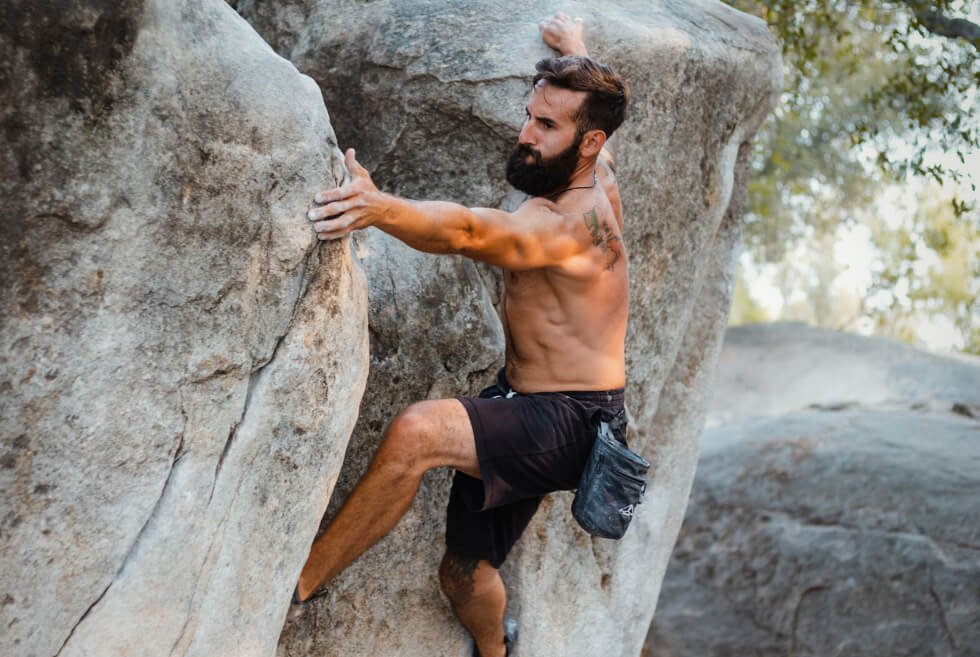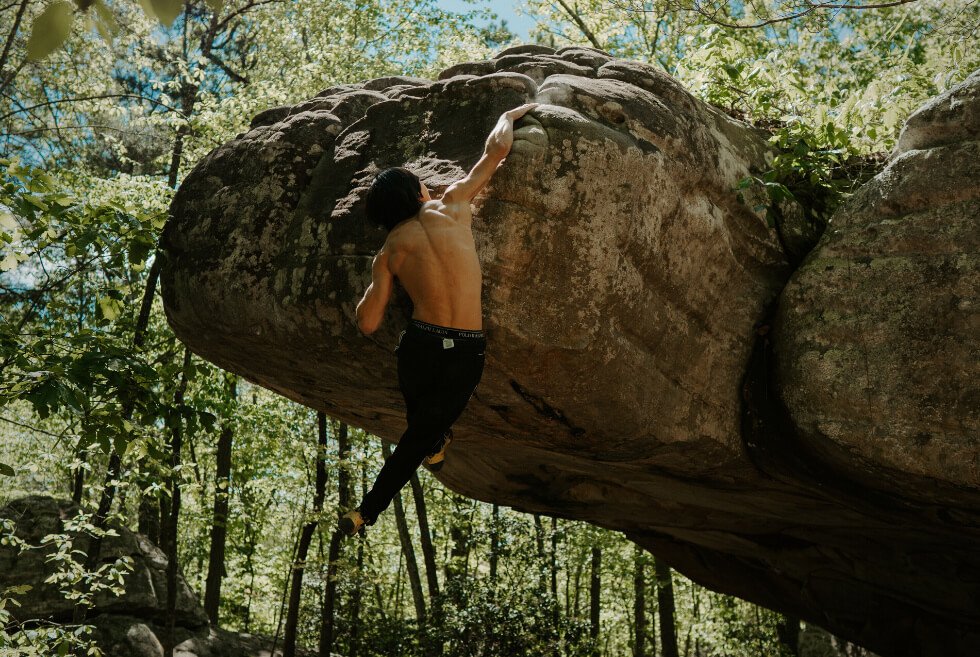
Contents
I am willing to bet you know someone who has recently taken up the sport of bouldering. Who knows, maybe you caught the climbing bug yourself and have become hooked on this exhilarating and addictive form of exercise.
This once niche mountain sport has quickly become a global sensation. It seems like everyone from A-list celebs to the biggest media outlets are captivated by this action-packed activity right now.
Because of its ever-growing popularity, we thought it was time we jumped on the bouldering bandwagon too. We have put together a beginner’s guide to bouldering, chock-full of all the common questions you might be asking. What is bouldering? What are the benefits of it? How does one even get started in the weird and wonderful world of climbing?
What is bouldering?
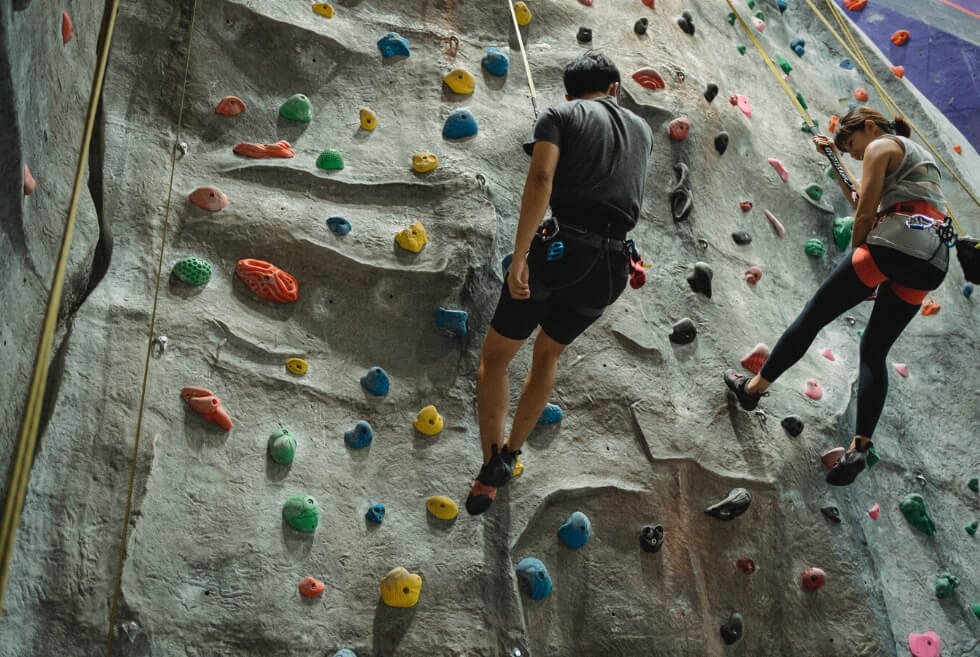
Bouldering is a style of rock climbing that involves scaling short ‘problems’ that are usually no higher than 15 feet. No ropes or harnesses are used here, instead, bouldering is practiced over mats, also known as crash pads, for protection.
The sport has origins dating back to the late 1800s when early mountaineers would scale small rocks as training for their larger alpine adventures. Over time, bouldering started to evolve into its own discipline, with areas like Fontainebleau in France, becoming one of the first prominent bouldering regions.
Unlike other forms of free climbing that usually involve a large array of equipment and specialized knowledge, bouldering focuses on completing a short sequence of moves (known as beta) in order to complete the climb. Each problem has an associated grade which helps the climber understand how easy, or difficult, the problem is. There are a few different grading systems that are currently in use, although the most common is the V Scale.
In climbing gyms, the grade is dictated by the routesetter (the person who puts the holds on the wall) whereas outdoors, the grade of a problem is set by the person to make the first ascent. Outdoor problems often change grades as more climbers complete the boulder and share their opinion on the proposed difficulty.
Why is bouldering so popular?
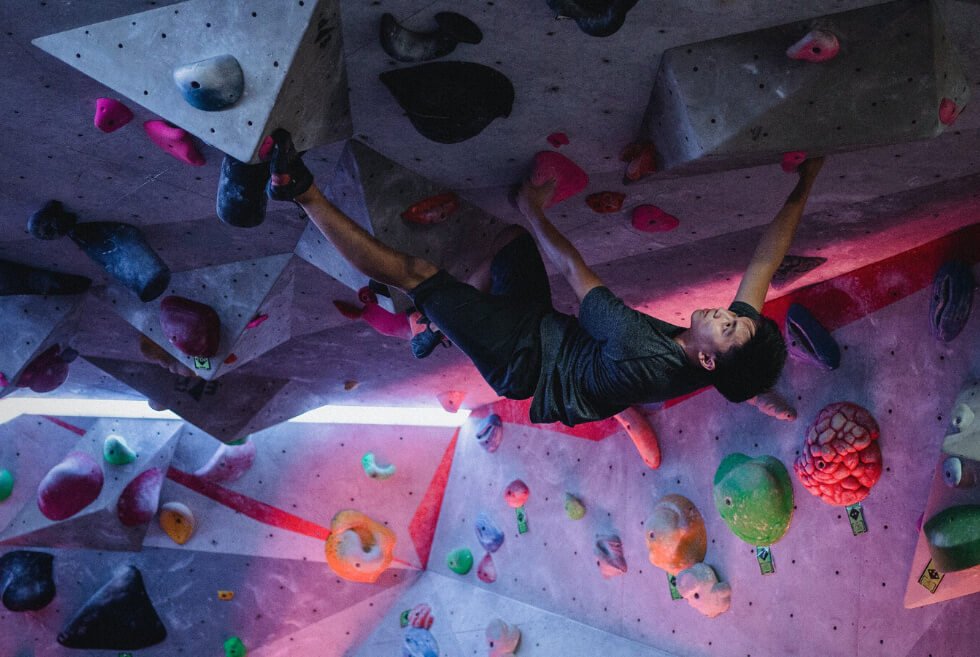
Because very little gear and mountain knowledge is needed, the amount of thrill-seekers taking up the sport has sky-rocketed over the past few years. It is estimated that 35 million people regularly slip into a pair of climbing shoes and that number has been growing by an estimated 15-20% every year.
The increased interest in bouldering, and rock climbing in general, has been fueled by a few significant events in recent years. The global spotlight was drawn to the sport in 2018, thanks to the popularity of award-winning documentaries like the Dawn Wall and Free Solo. These documentaries saw elite climbers make record-breaking ascents on the towering walls of Yosemite National Park, with the latter even receiving an Oscar in 2019 for Best Documentary Feature.
The Tokyo Olympic Games also undoubtedly had a large part to play in the recent flurry of interest in the sport. For the first time in history, 40 athletes went head-to-head in pursuit of becoming the first Olympic climbing champions. The sport’s Olympic debut was a huge success, it even went on to become one of the highest trending sports of the Games. Climbing gyms around the world even reported an instant uptake in new visitors after the Games.
The Benefits of Bouldering
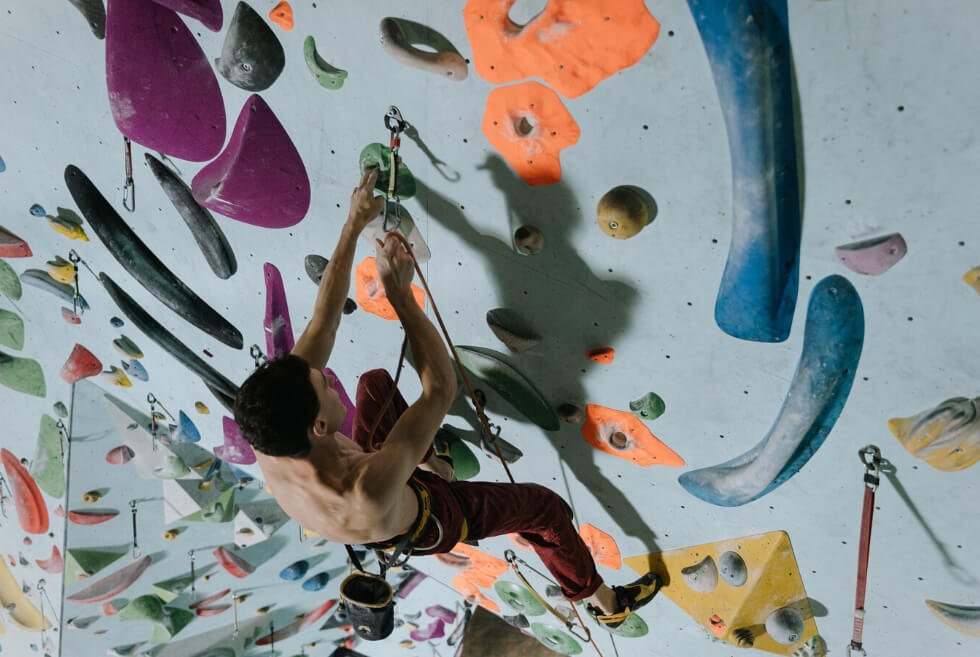
It’s not hard to see why so many people are getting in on the action, there is an endless amount of amazing benefits to bouldering. Here are a few reasons why we think it’s worth giving it a shot.
-
It’s a full-body workout
Bouldering belongs to an exclusive group of activities that provide a complete body workout. If you think about it, almost every major muscle group in your body is engaged when you climb. Your entire lower body is put to work as you nimbly push your way up the wall, while your upper body (especially your forearms, chest, and back) is continuously engaged as you pull on the plastic holds.
Unlike the more conventional methods of exercise – like running, cycling, or weightlifting – no two trips to the bouldering gym are the same. Because your muscles are exposed to a huge variety of movements, the diversity of your workout is virtually limitless. It is thought that diverse workouts like bouldering help avoid adaptive resistance, an occurrence where your muscles no longer respond to repetitive exercises.
This activity isn’t just for men and women with god-like physiques though. Climbing for exercise is something people of all shapes and sizes can enjoy. Because your whole body is being worked during your trip to the climbing gym, it is also great for helping you lose weight. It is thought that an hour of bouldering can burn well over 700 calories, rivaling intense cardio workouts like spinning or long-distance running.
-
It’s a workout for the mind too
The physical benefits of bouldering might be obvious but did you know about all the mental benefits too?
The inherent nature of bouldering essentially makes it a physical form of problem-solving, using your body position and muscle memory to solve the puzzle. The coordination required to complete a boulder problem is thought to help those with dyspraxia and assist in building strength and stability.
Besides the benefits bouldering has on your motor skills, research has even shown that it can help relieve stress, counter anxiety, and even reduce the effects of depression.
Of course, bouldering isn’t an exercise exclusively practiced in dark and dingy gyms. Make sure to get outside, visit some local crags, and explore some new places. This in itself offers plenty of awesome health benefits.
-
It’s easy (and cheap) to get started
Long gone are the days rock climbing was exclusive to rugged alpinists and hardcore outdoor enthusiasts. For most of us, our introduction to the world of bouldering will be through a trip to the local bouldering gym.
It is estimated that there are 600 climbing gyms located throughout the US right now. That number grows by about 3.9% every year, a rate of growth that dwarfs the opening of conventional gym and fitness clubs. No matter where you live, I guarantee that there is a bouldering gym lurking close by.
Unlike mainstream pastimes like golf or cycling which require an endless collection of expensive equipment, bouldering has relatively very few barriers to entry. All you need is a pair of indoor climbing shoes and a chalk bag. If you are unfortunate enough not to live near a bouldering gym, then simply add a crash pad to that kit list, and any rock formation becomes a bouldering opportunity!
-
It Improves flexibility
If you think flexibility is something reserved only for circus performers or ballet dancers, you would be sorely mistaken. Even if you are a 200lbs football player, flexibility is an essential component of physical fitness.
Working on your flexibility offers plenty of great benefits in every walk of life. Perhaps the biggest benefit is that having a greater range of movement allows your body to withstand more physical stress, which significantly decreases the risk of injury. It is also thought that by working on your flexibility you will see benefits in your posture, balance, and a reduction in general aches and pains.
If yoga or tai chi isn’t your thing, then bouldering is a great way to start improving your flexibility. Stretching for holds and completing problems increases blood circulation and improves your range of motion.
-
It’s Super Sociable
Perhaps the greatest benefit to climbing is the amazing community that surrounds the sport. There aren’t many sports that allow social cooperation quite as bouldering does.
Don’t feel nervous about bouldering alone either, every trip to the gym offers a new opportunity to strike up a conversation with a like-minded climber and share beta for that pesky project.
How to get into bouldering
Unlike other styles of climbing which require an eye-watering amount of kit (that probably cost more than your car), bouldering is relatively cheap and easy to get started with.
The first step in your plastic-pulling journey is to locate the local gym, the easiest way to do that is with a quick Google search. Once you have found it, decide on a time and date when you can put two hours aside for your first trip.
On that first visit, the gym staff will most likely give you a short introduction to bouldering. This usually entails a tour of the gym, a quick insight into their grading system, as well as a lesson on how to fall safely.
When it comes to the dress code, your usual workout attire will most likely be fine. For footwear, the gym’s rental shoes will suffice, at least for your first few trips. Once you start to get the bouldering bug, I would recommend picking up a good pair of bouldering shoes and a chalk bag to match, these are the essential accessories for the modern gym climber!
Before you start, don’t forget to do a quick warm-up. This not only helps prevent unwanted injuries, but it also helps you climb better for longer. Here’s a basic warm-up you can follow along with.
Don’t worry if you don’t have any friends that are willing to brave a trip to the gym, bouldering alone is great, I have no doubt there will be plenty of friendly faces to welcome you on every visit.
Ready to get climbing?
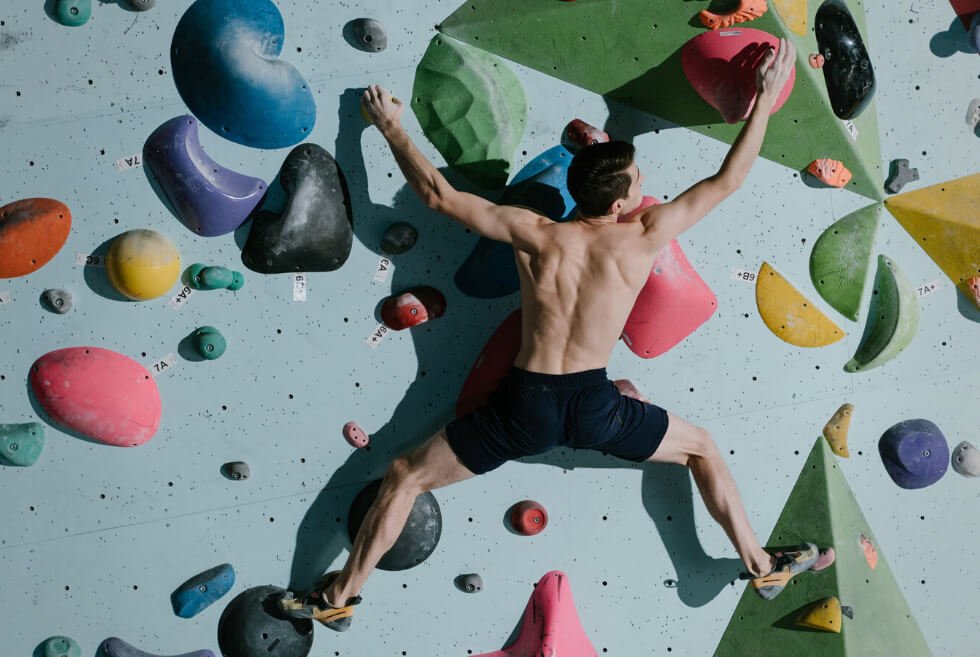
Love it or hate it, there’s no arguing that bouldering is a worldwide sensation that is here to stay. Not only does it provide significant benefits for your mind, body, and soul, it’s also just a good bit of fun. If you are looking for a new hobby, or just mind-numbingly bored of lifting weights at the gym, why not give bouldering a shot?
It might just become your new favorite activity.

